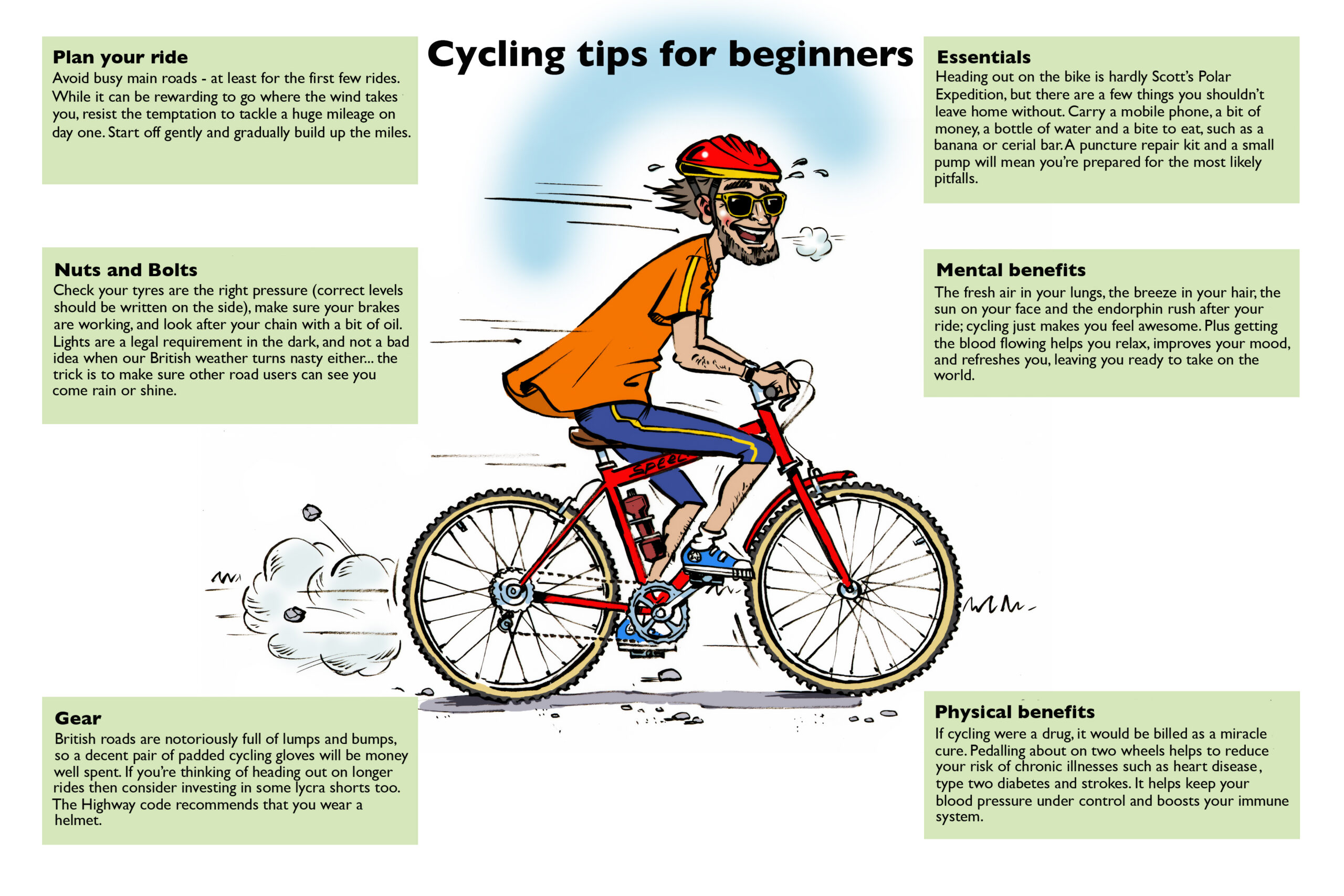As a professional author and avid cyclist at Top Biking, I am thrilled to share my knowledge and experiences with you on the topic of cycling tips for beginners. Cycling is not only a great way to stay fit and active, but it also offers numerous benefits for both physical and mental well-being.
However, there are some common misconceptions about cycling that may deter beginners from giving it a try. In this article, I will debunk these misconceptions and provide you with valuable insights into the world of cycling.
Choosing the Right Bike for You
When it comes to choosing the right bike, there are several factors to consider. First, you need to determine what type of bike suits your needs best. There are various types available such as road bikes, mountain bikes, hybrid bikes, and more. Each type has its own unique features that cater to different terrains and riding styles.
In my personal experience as a beginner cyclist many years ago, I found that a hybrid bike was the perfect choice for me. It offered the versatility I needed as I explored different terrains while providing comfort during longer rides. Additionally, considering factors such as frame size, weight capacity, and suspension can greatly impact your overall riding experience.
Essential Gear and Accessories for Cycling
Now that you have chosen your ideal bike, it’s time to equip yourself with essential gear and accessories before hitting the road or trail. The most important piece of gear is undoubtedly a helmet – never underestimate its importance in protecting your head from potential injuries.
When it comes to clothing choices for cycling enthusiasts like myself who live in areas with unpredictable weather conditions – layering is key! Wearing moisture-wicking fabrics helps keep sweat away from your body while providing insulation when needed.
Lights are another crucial accessory when cycling at night or in low-light conditions – they ensure visibility not only for yourself but also for other road users around you. Investing in high-quality locks is essential too; it provides peace of mind when leaving your bike unattended.
Basic Cycling Techniques and Safety Tips
Now that you have your bike and gear ready, it’s time to learn some basic cycling techniques and safety tips. Mounting and dismounting may seem simple, but proper technique ensures a smooth start to your ride. Practice mounting and dismounting in a safe area until you feel comfortable doing so.
Shifting gears is another fundamental skill to master. Understanding how different gears work will help you maintain an optimal cadence while riding uphill or downhill. Additionally, learning how to brake effectively is crucial for maintaining control and ensuring your safety on the road.
Riding in traffic can be intimidating for beginners, but with practice and knowledge of traffic rules, it becomes easier over time. Always ride predictably, use hand signals to indicate turns or stops, and make yourself visible by wearing bright clothing or using reflective accessories.
Planning Your First Cycling Route
As a beginner cyclist myself many years ago, I vividly remember the excitement of planning my first cycling route. Choosing a safe yet enjoyable route is essential for building confidence as well as avoiding potential hazards along the way.
Start by researching local bike paths or trails that are suitable for beginners – these often provide dedicated lanes away from heavy traffic. Utilizing maps or apps specifically designed for cyclists can greatly assist in planning your route by providing information on elevation changes, distance markers, rest areas, and more.
Building Endurance and Stamina for Longer Rides
Once you have gained confidence through shorter rides on familiar routes, it’s time to gradually increase both distance and intensity to build endurance and stamina. Pushing yourself too hard too soon can lead to burnout or injuries – trust me; I learned this lesson the hard way!
Cross-training activities such as swimming or yoga can complement cycling by targeting different muscle groups while improving overall fitness levels. Incorporating strength training exercises into your routine will also help prevent muscle imbalances and enhance your cycling performance.
Nutrition and Hydration for Cyclists
Proper nutrition and hydration are vital for optimal performance and recovery as a cyclist. Before embarking on a ride, fueling your body with a balanced meal or snack that includes carbohydrates, protein, and healthy fats will provide the necessary energy to sustain you throughout the ride.
During longer rides, it’s important to stay hydrated by drinking water or electrolyte-rich beverages regularly. Dehydration can lead to fatigue, cramps, or even heatstroke – all of which can hinder your cycling experience. After completing a ride, replenishing lost fluids and nutrients through post-ride snacks or meals is crucial for efficient recovery.
Dealing with Common Cycling Injuries and Aches
As much as we try to prevent them, injuries and aches are sometimes inevitable in the world of cycling. However, there are steps you can take to minimize their occurrence or alleviate discomfort when they do happen.
Prevention is key when it comes to common cycling injuries such as knee pain or lower back pain. Ensuring proper bike fit by adjusting saddle height and handlebar position can greatly reduce strain on these areas. Additionally, incorporating stretching exercises into your routine helps improve flexibility while reducing muscle tightness.
If you do experience persistent pain or discomfort that affects your ability to cycle comfortably – don’t hesitate to seek medical attention from professionals who specialize in sports medicine or physical therapy. They can provide targeted treatments specific to cyclists’ needs while helping you get back on track quickly.
Joining a Cycling Club or Group
One of the best ways to enhance your cycling experience is by joining a club or group of like-minded individuals who share your passion for riding. The benefits of joining such communities are numerous – from gaining valuable insights from experienced cyclists to finding new riding buddies who motivate each other along the way.
Finding the right club or group that fits your needs may require some research but is well worth the effort. Some clubs focus on competitive racing, while others prioritize social rides or charity events. Consider your goals and preferences when choosing a club or group to ensure a positive and enjoyable experience.
Incorporating Cycling into Your Daily Routine
Cycling doesn’t have to be limited to recreational rides on weekends – it can also become an integral part of your daily routine. Commuting by bike not only saves money on transportation costs but also provides an opportunity for exercise before and after work.
Running errands by bike is another practical way to incorporate cycling into your daily life. Invest in panniers or baskets that attach to your bike, allowing you to carry groceries, books, or other essentials conveniently.
Setting and Achieving Your Cycling Goals
Setting goals is essential for personal growth as a cyclist. By setting Specific, Measurable, Achievable, Relevant, and Time-bound (SMART) goals, you create a roadmap that guides you towards success.
Start with small achievable goals such as completing a certain distance within a specific time frame or conquering a challenging hill climb. As you achieve these milestones, celebrate them! Rewarding yourself for progress made will keep you motivated along the way.
In conclusion, cycling is not only a fun and rewarding activity but also offers numerous benefits for beginners who are willing to give it a try. By choosing the right bike for your needs and equipping yourself with essential gear and accessories, you set yourself up for success from the start.
Mastering basic cycling techniques while prioritizing safety ensures an enjoyable riding experience both on roads and trails. Planning routes that suit your skill level allows for exploration while building endurance gradually over time through cross-training activities enhances overall performance.
Proper nutrition and hydration play vital roles in sustaining energy levels during rides while preventing injuries through proper bike fit helps maintain comfort throughout longer distances. Joining cycling clubs or groups provides opportunities for learning from experienced riders while incorporating cycling into your daily routine saves money and promotes an active lifestyle.
Setting SMART goals and tracking progress ensures continuous growth as a cyclist. With the right gear, techniques, planning, and mindset, anyone can become a successful cyclist. So grab your bike, put on your helmet, and embark on this exciting journey – the road awaits!
FAQs
What is cycling?
Cycling is a form of exercise and transportation that involves riding a bicycle.
What are the benefits of cycling?
Cycling has numerous benefits, including improved cardiovascular health, increased muscle strength and flexibility, weight loss, and reduced stress levels.
What equipment do I need to start cycling?
To start cycling, you will need a bicycle, a helmet, and comfortable clothing and shoes.
What type of bicycle should I get?
The type of bicycle you should get depends on your intended use. For casual riding, a hybrid or comfort bike is a good choice. For more intense riding, a road bike or mountain bike may be more appropriate.
How do I properly fit a bicycle?
To properly fit a bicycle, adjust the seat height so that your leg is almost fully extended when the pedal is at the bottom of its rotation. Adjust the handlebars so that they are at a comfortable height and distance from the seat.
What are some safety tips for cycling?
Some safety tips for cycling include wearing a helmet, using hand signals when turning, obeying traffic laws, and staying visible to motorists.
How can I improve my cycling skills?
To improve your cycling skills, practice regularly, vary your routes and terrain, and consider taking a cycling class or working with a coach.
What should I eat before and after cycling?
Before cycling, eat a meal or snack that is high in carbohydrates and low in fat and fiber. After cycling, eat a meal or snack that is high in protein and carbohydrates to aid in muscle recovery.
Originally posted 2024-01-13 03:17:23.





